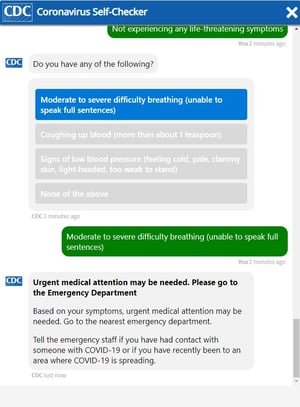Alleviate the strain on call centres with chatbots
Written by Luke Stamper
In recent weeks, a synonymous experience for most companies of all natures and sizes throughout the UK, has been the changes in demand from their customers. This pressure has been particularly prevalent for companies providing services like water, energy, retail, healthcare, insurance and banking.
As consumers in the UK and many parts of the world respond to being told they have to stay home for at least another three weeks, the demand on some companies has increased dramatically, whilst simultaneously, large percentages of their work force are now working from home, or have been furloughed to ensure businesses don’t go under.
As mentioned in our previous blog, customer contact centres across the country have experienced real challenges around serving their customers, and many calls have unfortunately gone unanswered, leaving companies such as NatWest and British Gas only opening their phone lines to customers in vulnerable circumstances and emergencies.
However, there is a way of alleviating this pressure on customer contact centres, enabling customers to self-serve and improving your overall customer experience.
Here are some examples of how effective chatbots can be in managing enquiries…
Gov.uk
In recent weeks, the Government has launched a WhatsApp chatbot to provide NHS advice, aiming to take the pressure off the NHS 111 service which quickly became inundated with enquiries regarding when and how to self-isolate, what the symptoms of COVID-19 were, and how to prevent the spread of the disease.
To access the GOV.UK chatbot, users simply have to add 07860 064422 to their contact list and send the word “hi” to access their Coronavirus Information Service, where they answer questions on a range of topics including myth-busting, mental well-being, travel advice and latest contact numbers.
CDC (Centres for Disease Control and Prevention)
 The CDC (US based) have also recently introduced a chatbot to quickly serve users who are looking to identify potential symptoms of COVID-19. Working with Microsoft to produce the tool, they have created a service that asks users a range of questions, determining their location within the US, and asking several questions about their symptoms, how long they have experienced those symptoms, how severe they are etc.
The CDC (US based) have also recently introduced a chatbot to quickly serve users who are looking to identify potential symptoms of COVID-19. Working with Microsoft to produce the tool, they have created a service that asks users a range of questions, determining their location within the US, and asking several questions about their symptoms, how long they have experienced those symptoms, how severe they are etc.
After completing the questions, the chatbot will then guide the user on what the next steps are, advising them on whether or not to attend their local emergency room.
The service is now tracking millions of interactions each day, enabling users to quickly self-screen their symptoms. The service has also enabled Microsoft to track the outbreak of the disease and gain detailed information about the outbreak in the US.
The AA
We have recently worked with The AA to implement a chatbot to provide faster access to some of their key digital services. Looking to deflect a number of contacts coming through it’s call centre to enhance the help and support it provides to customers in critical or complex situations – like those having broken down on the side of the motorway.
To achieve this, the chatbot needed to divert low value customer interactions away from the contact centre and into The AA’s other digital channels instead. 85% of the customer contacts from its members were coming through via the call centre; the AA’s ambition was to reduce this to 50%.
We worked with the AA to implement a chatbot that enables customers to change their address and change their vehicle. Since implementing the service, the bot has handled 450 conversations per day, enabling customers to change their address and update their vehicle registration in less than three minutes, reducing call volumes to the call centre and enabling customers to self-serve.
Here’s an example of how the chatbot manages a customer’s request:
So, what are some of the benefits of integrating a chatbot into your digital offering?
- Improve your CSAT scores;
- Increase customer engagement;
- Gain insights into your customer’s requirements;
- Reduce call volumes to busy call centres;
- Free up customer contact personnel to deal with priority calls and customers in vulnerable circumstances.
Implementing a chatbot into your customer experience programme can ultimately help your customers to self-serve and complete tasks more simply and efficiently and help you to demonstrate an innovation-led approach to your customers.
If you’d like to understand how off-the-shelf services can be applied to give increased meaning and intelligence to customer interactions, to structure information and surface recommendations and responses based on customer data, then get in touch.
We’ll work with you to identify potential use cases for AI across your customer journeys, on web, chat, and voice channels, and prioritise key use cases that will improve your customer experience.
What else is going on
-
March 2024
Ghost Spam in GA4 – How to Spot and Deal With It
How to spot and deal with ghost spam in Google Analytics 4 (GA4) to safeguard your data insights. Implement proactive measures to maintain data accuracy.
-
November 2023
Mando to bridge skills gap at BIMA Digital Day
The BIMA Digital Day on November 8th is an attempt to bridge this skills gap, as eight of Mando's experts will spend time with around 240 Year 10 students from The Studio School at their Liverpool campus.
